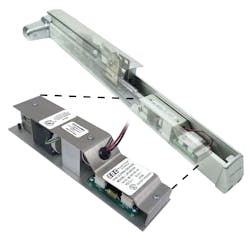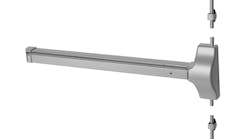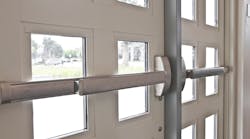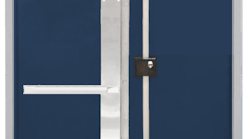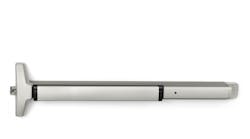The first version of a panic bar was patented in England in 1892. We here in the United States regard the tragic deaths at Chicago’s Iroquois Theatre in 1903 as the event that inspired the invention and granting of nine patents for the Von Duprin 88 exit device in 1908 and when the exit device gained relevance as a serious pursuit of life safety.
The 88 was invented, developed and distributed by the combined efforts of manager Carl Prinzler at Vonnegut Hardware and architectural engineer Henry H. DuPont. The exit device allowed buildings to have a door locked from the outside while still providing immediate egress from the inside.
Prinzler was inspired by the Iroquois tragedy. He had planned to attend the event that day, didn’t make it and interpreted his salvation as a sign to make it his mission to invent a hardware solution that might prevent the loss of further innocent victims.
Eventually, building codes started to require that certain openings that were critical for occupant egress be out-swinging and equipped with readily recognizable and simple-to-operate exit devices.
Today, exit devices are an essential and flexible architectural hardware item. Besides increasing the safety and security of a structure, exit devices provide the locksmith with lots of opportunities for selling, maintaining and upgrading.
Many high-quality exit devices are available, and they vary in style, type and options. The exit device can be adapted readily to electronic access control and special locking arrangements. Different vendors provide unique features, and the challenge is to specify the right product for the particular application. The only real limitation is the particular code requirements for the occupancy and opening into which you install the exit device.
Exit devices typically are builders’ hardware and are included in bid specs. Often, the general contractor or companies involved in doors and door operators install them. I mention this because we performed many installations of exit devices on corporate, municipal and educational projects in conjunction with other locksmithing work, including electronic access and lock and key systems.
I also won some terrific accounts by being able to follow the general contractor or the door operator contractor onto a site and correct all the mistakes and poor workmanship left behind because of their lack of technical expertise or commitment to performing professional security services. When dealing with complex mechanical devices, the devil is in the details, and that might be overlooked and not make a project punchlist.
So, in a rapidly changing market, the locksmith can rely on their technical competence and work ethic as differentiators to remain successful in this business. Having knowledge of exit devices and features available also is helpful while specifying and making sales.
Here are a few exit devices in the market today, with an emphasis on electrification and features that electrifying the device delivers.
SDC Quiet DUO LR 100 ELR Kits
The Quiet DUO LR 100 ELR Kits are part of SDC’s approach to exit devices. The approach is focused on providing locksmiths, dealers and integrators with opportunities in retrofitting existing mechanical devices to electronic. This allows them to be integrated into access control systems while maintaining security, fire and life-safety compliance in a cost-effective manner.
Central to this theme is a retrofit via motorized latch retraction kits to enable electronic access control and dogging of mechanical exit devices. Quiet DUO LR 100 ELR Kits retrofit most major brands of mechanical exit devices — many without removing the device from the door. Also, upgrading the solenoid to a motor in the ELR kit reduces power consumption and increases the device’s product life.
When energized, the motor retracts the exit device latch and pulls the push pad on most devices into the dogged (depressed) position. This enables momentary or sustained push and pull operation of the door.
The kit’s low 700-milliamp inrush and 200-milliamp continuous power at 24VDC eliminates the necessity for costly power supplies that have high inrush circuitry.
Also, no door sequencers are required for pairs of manual doors.
More info: www.sdcsecurity.com/LR100
SDC S4000
SDC’s S4000 exit devices have factory-installed MLR and REX monitoring standard. This facilitates easy integration into access control systems for commercial and industrial markets. SDC also recognized that many of these types of compact exit devices are used in applications where corrosion resistance through stainless steel design is beneficial.
The S4000 also has electric dogging to hold the latch retracted as well as rim and surface vertical-rod models available. Multiple
trim options also are available, and the exit devices can be used on hollow metal, wood and mineral core doors.
More info: www.sdcsecurity.com/S4000
Adams Rite 8000/3000 Series
ASSA ABLOY company Adams Rite has a variety of life-safety and fire-rated exit devices built to meet building codes and Americans with Disabilities Act guidelines. The 8000/3000 Series is Adams Rite’s most complete line of exit devices and related hardware. It includes a variety of styles, including surface and concealed vertical rods, mortise door exits, rim exits and dummy push bars.
The Motorized Latch Retraction (MLR) option is available for all 8000/3000 Series exit devices. MLR incorporates a powerful and efficient motor to unlatch the exit device.
The MLR option is calibrated in the factory, so locksmiths don’t have to handle that in the field, which allows for an easier and more efficient installation. In addition, the option includes audible chirps for calibration confirmation and to confirm bar binding.
Note: The MLR option has replaced the legacy Silent Electrification (SE) Motorized Latch Retraction.
More info: www.adamsrite.com
Securitech LEXI
The LEXI retrofits control trim for exit devices. It retrofits the trim for all major lock manufacturers’ exit devices.
Also, the control trim is electrified within the trim, so an electrified strike isn’t necessary. That helps to make the LEXI easy to install, because no cutting into the frame is required.
Retrofitting the LEXI Control Trim to various exit devices is made possible by Securitech mounting plates and operators. Each mounting plate and operator is created specifically with a particular exit device in mind.
The lever can be unlocked by a key, card access, keypad, intercom or other release, and the trim’s stainless steel slip-clutch lever handle will break away when forced. It has an easy reset by just lifting it up.
More info: www.securitech.com
Detex Electrified Options
Detex is the only manufacturer that has these two electrified options: delayed egress with latch retraction and weatherized electric latch retraction (ELR).
The Delayed Egress with Latch Retraction (EE ER) option is designed for applications where delayed egress and remote unlocking, remote dogging, access control or an automatic operator is desired. Optional exit switches may be added for pushpad monitoring or latch-bolt monitoring.
The wall-mounted Remote Interface Module includes an alarm that puts out about 100 decibels of sound when someone attempts to exit. The alarm will continue but the door will remain locked for 15 seconds, which deters unauthorized exit and provides time to respond to the alarm. Red/green LEDs indicate the alarm is armed.
This option is available as a stand-alone product or in a fully integrated EasyKit. All delayed-egress and access control functions are implemented in the exit device. No external magnets, electric strikes or electric trims are necessary.
The option also is compatible with a through-wire hinge or power transfer.
Meanwhile, the Weatherized Electric Latch Retraction (ER EX W) function is designed for exit doors that have panic or fire exit hardware exposed to weather environments where remote unlocking, remote dogging or access control is desired. A power supply and controller must be installed in a NEMA 4X enclosure or located in a controlled, moisture-free environment.
The option works with any type of access control system and provides a means for remote dogging and lockdown. The latch-retraction device comes standard with a request-to-exit (REX) push-pad switch (EX).
More info: www.detex.com
Von Duprin M996 Electrified Trim
Motor-driven options, such as the Von Duprin M996 electrified trim by Allegion, consume less power and require fewer power supplies than do their solenoid counterparts. This makes them more efficient and cost-effective for your customers.
The M996 motor can be energized from a distant controller, which makes it suited for the control of stairwells in high-rise buildings.
For added security, the M996 breakaway trim features a patented vandal-resistant design. When more than 35 pounds of pressure is applied, the lever dangles so the internal components are protected from breakage — all while remaining locked.
The M996 trim can be ordered with an exit device or added to an existing Von Duprin 98/99 series device, or a conversion kit can be added to existing 996L/996L-BE or E996L/E996L-BE trim.
The trim works with 12VDC or 24VDC power supplies. It’s furnished fail-safe but can be converted to fail-secure via a dip switch.
More info: us.allegion.com
Precision Hardware MLR Exit Device
The MLR Exit Device by dormakaba brand Precision Hardware is an electromechanical option available on all APEX 2000 series exit devices. It enables access control with electric latch or push-bar retraction. Other benefits include:
- Reduced operational noise. MLR advanced motor technology reduces noise, which makes it suitable for applications where quiet is desired, such as hospitals, museums and libraries.
- Low current requirement. Each MLR requires 24 volts @ 1.5 amps and draws less power than a solenoid.
- Long-distance wire runs. The low-current requirements enable wire runs of up to 800 feet. This means power supplies can be stored in consolidated electrical closets that are farther away from the opening.
- Seamless interface and universal function. The MLR Exit Device works with automatic swing-door openers, card readers, push-buttons, toggle or key switches and fire-alarm systems.
- Easy integration. The RPMLR-K retrofit kit allows for easy updating of existing hardware.
More info: www.precisionhardware.com
Tim O’Leary is an experienced security consultant and a regular contributor to Locksmith Ledger.
